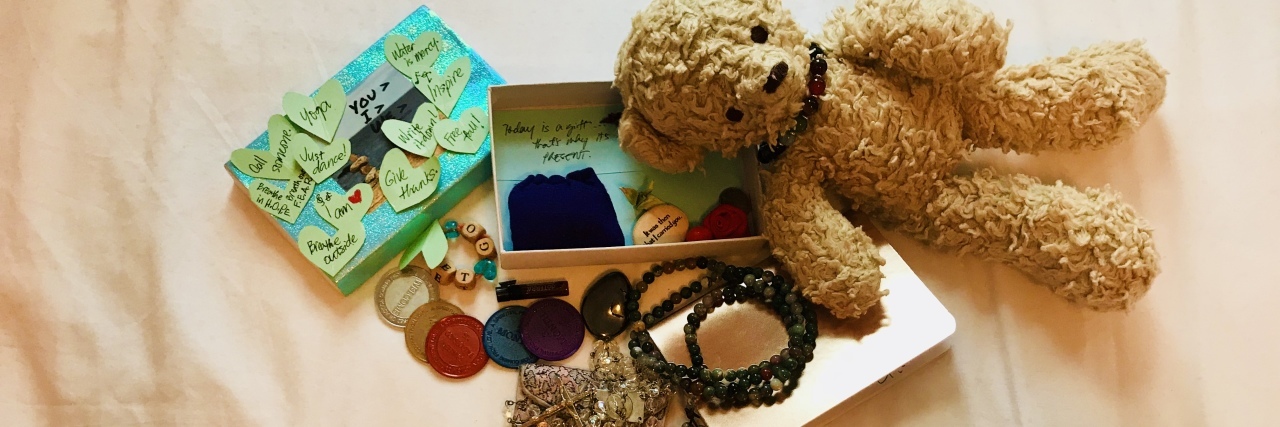5 Things I Put in My 'Coping Box' as Someone With Borderline Personality Disorder
When I was triggered by the pervasive news about a celebrity’s suicide, a small blue and white box saved my life. I call it my “coping box,” as it helps me cope with intense emotions.
This life-saving collection goes by many names: crisis kit, self-soothe kit, safety kit, anxiety kit, self-care survival kit and more. It comes in all shapes and sizes: pouches, bags or boxes.
You can have more than one kit, in as many places as you need: a pouch in your purse, a bag in your car, a box in your bedroom and wherever else you can easily access it when triggered.
All these kits have one purpose: to help you pass time safely as you work through distress or a crisis. “Safely” is the key word.
When you’re caught in the grip of helplessness, panic, fear or anger, it is difficult — and oftentimes almost impossible — to think rationally. It is like being caught unexpectedly by a monster wave in the ocean. It pulls you under, sucks the breath out of you, tosses you about like flimsy seaweed. You don’t know which way is up to the surface, to where you can breathe again. If you don’t get air, you will drown.
Being in distress is like that. You don’t think, you just react. You easily slip into conditioned, sometimes harmful, reactions like lashing out, self-harm or suicidal thoughts. You may impulsively make choices that make the situation worse.
How do you save yourself?
Scuba divers follow their bubbles when they don’t know which way is up. Divers may get so immersed in their surroundings that they swim sideways or go deeper unknowingly. They get disoriented. Those bubbles are reliable indicators of reality — underwater bubbles always rise to the surface.
The contents of your crisis kit are the bubbles that will lead you to safety. When you follow them, you will breathe again.
Since we all have different triggers and soothers, no crisis kit is the same. It’s not something you can buy off the shelf. It is something you create for yourself (or for another person), taking thoughtful care in selecting each item.
In putting together my coping collection, I chose meaningful items that remind me of what I value: the people in my life, my accomplishments, my life purpose — as well as activities I can do to safely ride the intense waves of feelings that threaten to overwhelm.
My box holds mementos that remind me of the good in life.
1. Gratitude.
I wrote down the quote, “Today is a gift… that’s why it’s called the present” on the lid. It encourages me to find the gift in each triumph or trial and give thanks for it.
2. Perseverance
The power of perseverance is symbolized by five multi-colored chips I earned in three months of going to meetings of a 12-step recovery group.
3. Love.
I stuck two photos of my smiling daughter on the lid. The joy and laughter captured in those moments lift my spirits up.
4. Solace in my Higher Power.
A smooth sandy stone etched with a pair of footprints and the phrase, “It was then I carried you” recalls the poem “Footprints in the Sand.” A ring of wood and plastic beads spelling “Let go” reminds me to “let go and let God.”
5. Self-Care
Self-care is not selfish. A purple perfumed pillow I made from an old t-shirt reminds me it is OK to take the time and space I need.
The rest of the items in my coping box are straightforward. They are just green paper hearts with specific instructions to distract me and divert my focus away from the distress. Here’s what they say:
1. Breathe and count the seconds. Step outside and breathe in outdoor scents.
2. Give thanks for every item that catches your eye.
3. Play a favorite video game.
4. Listen to music, offering three carefully curated playlists: Inspire, Stronger and I am Love.
5. Write: describe the moment’s sensations, thoughts and emotions.
6. Move your body. Do a yoga pose. Dance. Run.
7. Call someone — therapist, sponsor, friend, a warm line or the hotline.
“Call someone” is intentionally mentioned last because I want to strengthen my ability to self-regulate.
I strengthen my ability to self-regulate by practicing these skillful activities when I am not in distress. With practice, these learned behaviors hopefully become habits.
If you deal with panic, anxiety or depression in any form, carry your crisis kit all the time. Another helpful carry-along is a self-soothing item like prayer beads or stuffed toy that you can quickly hold onto and get grounded.
Remember, relief or feeling better is not the goal. Neither is finding solutions nor making plans. There is only one goal: passing time safely.
The contents of your safety kit are intended to help you get through the triggers and overpowering feelings. Use them — that’s how you save your life.
What’s in your crisis kit? Share in the comments below. You might inspire someone!
Photo via contributor

